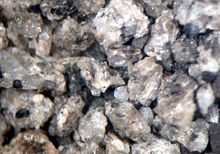Cardium Formation
| Cardium Formation Stratigraphic range: Turonian to Coniacian | |
|---|---|
 Photomicrograph of drill cuttings from Cardium Formation sandstone. | |
| Type | Geological formation |
| Unit of | Alberta Group, Colorado Group, Smoky Group |
| Sub-units | Sturrock Member, Leyland Member, Cardinal Member, Kiska Member, Moosehound Member, Ram Member. |
| Underlies | Wapiabi Formation |
| Overlies | Blackstone Formation, Kaskapau Formation |
| Thickness | 22 metres (70 ft) to 109 metres (360 ft)[1] |
| Lithology | |
| Primary | Sandstone |
| Other | Shale |
| Location | |
| Coordinates | 51°08′28″N 114°59′40″W / 51.14101°N 114.99446°WCoordinates: 51°08′28″N 114°59′40″W / 51.14101°N 114.99446°W |
| Region |
Western Alberta, and northeastern British Columbia |
| Country |
|
| Type section | |
| Named for | Cardium shells |
| Named by | James Hector, 1895[2] |
The Cardium Formation is a stratigraphic unit of Late Cretaceous age in the Western Canada Sedimentary Basin. It takes the name from the fossilized Cockle (Cardiidae) shells that it contains, and it was first described along the Bow River banks by James Hector in 1895.[2] It is present throughout western Alberta and in northeastern British Columbia, and it is a major source of petroleum and natural gas.[3]
Lithology

- Sturrock Member (sandstone)
- Leyland Member (shale)
- Cardinal Member (sandstone)
- Kiska Member (shale)
- Moosehound Member (shale)
- Ram Member (sandstone)
In central Alberta, the formation is divided into the Pembina River Member and Cardium Zone.
Distribution
The Cardium Formation was deposited during the Turonian and Coniacian stages of the Late Cretaceous along the western edge of the Alberta Foreland Basin.[3] It extends northward from the Canada-United States border to northeastern British Columbia near Dawson Creek, and eastward from the foothills of the Canadian Rockies into the plains of southern and central Alberta. Beyond there, the sandstones grade into shale.[1]
Relationship to other units
Due to its large areal extent, the Cardium Formation falls within different stratigraphic groups in different regions (Alberta Group, Colorado Group, and Smoky Group). It is conformably overlain by the Wapiabi Formation and underlain by the Blackstone Formation. The formation is partly equivalent to the Kaskapau Formation.[1]
Hydrocarbon production
Natural gas is produced from the Cardium Formation in the Athabasca River area and the foothills in western Alberta, and oil is produced in the Pembina oil field of central Alberta.[4] The sandstones of the formation have good storage potential and stratigraphic traps are formed by the thick overlying shales of the Wapiabi Formation and Muskiki Formation, while the underlying black shale of the Blackstone Formation and Kaskapau Formation are good source rocks.[3]
The Cardium Formation had an initial established recoverable oil reserve of 305 million m³, with 220.9 million m³ already produced as of 2008.[5] Gas reserves totaled 88.3 million e³m³, with 30.8 million e³m³ already produced.[5]
Drilling for oil in the Cardium Formation rebounded in 2009 when horizontal drilling and multi-stage fracturing technology increased the oil recovery factor.[6] Driven by technology, drilling in the four decades old Pembina oil field increased, re-launching the field to the center of Alberta's oil economy.
Public companies
Throughout 2009, there has been consolidation underway, where land sales, corporate transactions, and consolidation of public companies with Cardium assets have been acquired by those intending to apply newer recovery techniques to improve field economics. Oil and gas companies that are part of this activity include: PetroBakken (TSX: PBN, through its acquisitions of Berens Energy, Result Energy and Rondo Petroleum), Daylight Resources Trust (TSX: DAY, through its acquisition of Highpine Energy and merger with West Energy, TSX: WTL), PennWest (TSX: PWT.UN, with a large land base), Paramount Resources (TSX: POU through its acquisition of Profound Energy),Bonterra Energy, Crescent Point Energy (TSX: CPG, through its acquisition of TriAxon Resources), and the smaller Bellatrix (TSX: BXE), Delphi Energy (TSX: DEE), Peyto Energy Trust (TSX: PEY.UN). Dozens of other companies have land leases in the Cardium fairway, but have not employed horizontal drilling in the Cardium. Exxon Mobil has recently started testing the Cardium Formation [7]
References
- ↑ 1.0 1.1 1.2 Lexicon of Canadian Geologic Units. "Cardium Formation". Retrieved 2009-02-07.
- ↑ 2.0 2.1 as reported in Whiteaves, J.F. 1895, Some of the Cretaceous fossils collected during Captain Palliser's explorations in British North America in 1857-60. Proc. and Trans., Royal Society of Canada, 2nd Ser., vol. 1, pp. 110.
- ↑ 3.0 3.1 3.2 Alberta Geological Survey. "Cretaceous Cardium Formation of the Western Canada Sedimentary Basin". Retrieved 2009-03-06.
- ↑ Alberta Geological Survey. "Cardium Formation isopach map with distribution of major Cardium Formation oil and gas fields". Retrieved 2009-03-06.
- ↑ 5.0 5.1 Mossop, G.D. and Shetsen, I - Canadian Society of Petroleum Geologists (1994). "The Geological Atlas of the Western Canada Sedimentary Basin - Summary of oil reserves and production data". Retrieved 2009-03-06.
- ↑ "Cardium Fairway". Retrieved 2010-03-26.
- ↑ "Exxon Mobil testing the Cardium Shale". Retrieved 2012-02-18.
| ||||||||||||||